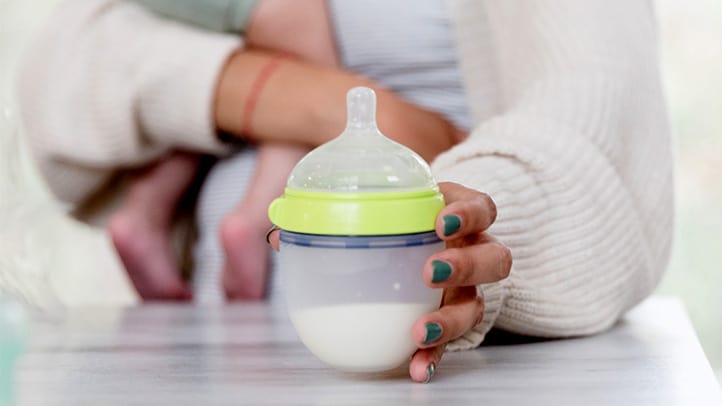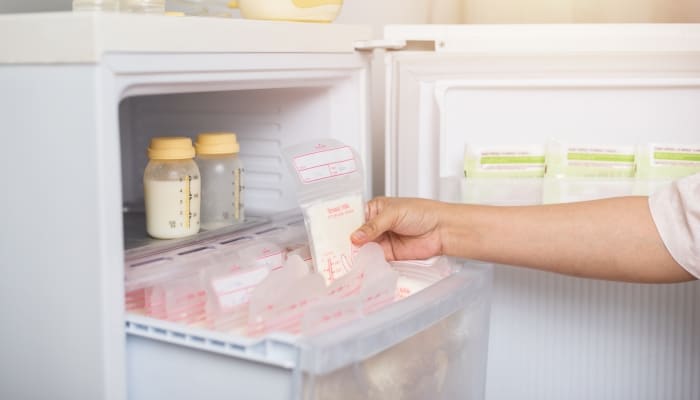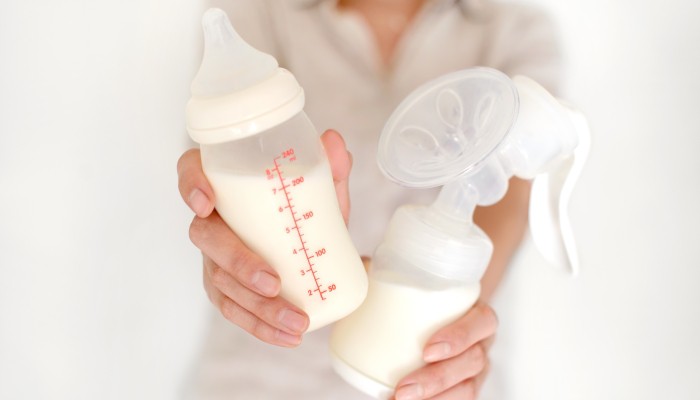Spoiled breast milk can be a concerning issue for mothers who want to provide the best possible nutrition for their babies. Breast milk is a complex fluid that contains a variety of nutrients and immune-boosting components that help protect infants from infections and illnesses.
However, when breast milk spoils, it can develop an unappealing appearance, odor, and taste that may make babies refuse to drink it.
Recognizing spoiled breast milk is essential for ensuring that infants receive the best possible nutrition. Spoiled breast milk can have a sour, rancid, or soapy smell, and it may appear clumpy, lumpy, or discolored.
Some mothers may notice that their breast milk smells or tastes metallic, which can be a sign of excess lipase activity. Understanding the signs of spoiled breast milk can help mothers identify potential issues and take steps to prevent milk spoilage.
Breast milk composition and spoilage are complex topics that require careful attention to detail. Proper storage, handling, and preparation techniques are crucial for minimizing the risk of milk spoilage and ensuring that infants receive high-quality nutrition.
By understanding the factors that contribute to breast milk spoilage and taking proactive steps to prevent it, mothers can help ensure that their babies receive the best possible nutrition.
Key Takeaways
- Recognizing the signs of spoiled breast milk is essential for ensuring that infants receive high-quality nutrition.
- Proper storage, handling, and preparation techniques are crucial for minimizing the risk of milk spoilage.
- By taking proactive steps to prevent milk spoilage, mothers can help ensure that their babies receive the best possible nutrition.
Recognizing Spoiled Breast Milk

Breast milk is a precious commodity for nursing mothers and their babies. It is important to recognize when breast milk has spoiled to avoid feeding it to a baby. Spoiled breast milk can cause digestive problems and even make a baby sick.
Here are some ways to recognize spoiled breast milk.
1. Appearance
One of the easiest ways to recognize spoiled breast milk is by its appearance. Spoiled breast milk may have a yellow or brown tint, and it may appear clumpy or contain small white specks. It may also separate into layers, with a thick layer on top and a watery layer on the bottom.
2. Smell
Spoiled breast milk has a distinct smell that is different from fresh breast milk. It may have a rancid smell, similar to spoiled cheese or meat. It may also have a soapy smell or a sour smell.
To test the smell of breast milk, pour a small amount into a clean cup and give it a sniff. If it smells off or unpleasant, it may be spoiled.
3. Taste
Spoiled breast milk may also have a different taste than fresh breast milk. It may taste sour or metallic. Some babies may refuse to drink spoiled breast milk because of the taste.
To test the taste of breast milk, pour a small amount into a clean cup and give it a taste. If it tastes off or unpleasant, it may be spoiled.
In conclusion, recognizing spoiled breast milk is important for the health and well-being of nursing mothers and their babies. By paying attention to the appearance, smell, and taste of breast milk, mothers can ensure that they are feeding their babies fresh, healthy milk.
Breast Milk Composition and Spoilage
Breast milk is a complex mixture of nutrients, enzymes, and other substances that provide optimal nutrition for infants. The composition of breast milk can vary depending on several factors, including the mother’s diet, age, and health status.
However, one of the most important components of breast milk is its fat and protein content.
1. Fat and Protein Content
Breast milk contains a high concentration of fat, which is essential for the growth and development of the infant’s brain and nervous system. The fat content of breast milk can vary depending on the mother’s diet and the stage of lactation.
For example, the fat content of colostrum, the first milk produced after birth, is much higher than the fat content of mature milk.
In addition to fat, breast milk also contains a variety of proteins, including casein, whey, and lactoglobulin. These proteins provide essential amino acids that are necessary for the growth and development of the infant.
2. Enzymes and Spoilage
Breast milk also contains enzymes, including lipase, which is responsible for breaking down fats in the milk. However, in some cases, high levels of lipase can lead to the spoilage of breast milk.
When breast milk with high lipase levels is stored, the fat in the milk can break down and produce a rancid odor and taste.
To prevent spoilage, it is recommended that mothers scald their milk before storing it. Scalding involves heating the milk to a temperature just below boiling, which can inactivate the lipase enzyme and prevent spoilage.
In conclusion, breast milk is a complex mixture of nutrients, enzymes, and other substances that provide optimal nutrition for infants. The fat and protein content of breast milk are essential for the growth and development of the infant, while enzymes such as lipase can lead to spoilage if not properly managed.
Mothers should be aware of the composition of their breast milk and take steps to prevent spoilage to ensure the highest quality nutrition for their infants.
Breast Milk Storage Guidelines

Breast milk is a valuable source of nutrition for infants, and proper storage is essential to maintain its quality and safety. Here are some guidelines for storing breast milk:
1. Refrigerator Storage
Freshly pumped breast milk can be stored in the refrigerator for up to 4 days. It is best to use glass or hard plastic containers with tight-fitting lids or milk storage bags designed for storing breast milk. Label each container with the date and time it was expressed.
When storing breast milk in the refrigerator, it is important to place it in the back of the fridge, where the temperature is the coldest. Avoid storing it in the door, as the temperature can fluctuate with frequent opening and closing.
2. Freezer Storage
Breast milk can also be stored in the freezer for longer periods of time. It is recommended to use milk storage bags or hard plastic containers that are specifically designed for freezing breast milk. Label each container with the date and time it was expressed.
The Centers for Disease Control and Prevention (CDC) recommends the following guidelines for safe storage of breast milk in the freezer:
- In a freezer compartment inside a refrigerator: up to 2 weeks
- In a separate deep freezer: up to 6 months
It is important to note that the longer breast milk is stored, the greater the loss of vitamin C and other nutrients.
In conclusion, following these breast milk storage guidelines can help ensure that stored breast milk is safe and of high quality for your baby’s consumption.
Scalding and Milk Spoilage
Scalding breast milk is a process that involves heating the milk to a temperature that is just below boiling. This process can help to kill off any bacteria that may be present in the milk, thereby reducing the risk of spoilage.
In addition to this, scalding can also help to break down some of the enzymes that can cause milk to spoil.
One of the most common causes of milk spoilage is chemical oxidation. This occurs when the milk is exposed to air, light, or heat for an extended period of time. When this happens, the milk can take on a rancid or sour smell, and it may also develop a yellow or brownish color.
Scalding breast milk can help to prevent chemical oxidation from occurring. By heating the milk, the enzymes that can cause spoilage are broken down, and the milk is also sterilized, which reduces the risk of bacterial growth.
It is important to note that scalding breast milk should be done carefully, as overheating the milk can cause it to spoil more quickly. It is also important to use a clean, sterile container to store the milk after it has been scalded.
In summary, scalding breast milk can be an effective way to prevent milk spoilage and reduce the risk of bacterial growth. By heating the milk to a temperature just below boiling, the enzymes that can cause spoilage are broken down, and the milk is sterilized.
However, it is important to handle the milk carefully and store it properly to ensure that it remains safe to consume.
Effects of Spoiled Milk on Babies

When breast milk is not stored properly or for too long, it can spoil and affect the health of the baby. Here are some of the effects of spoiled milk on babies:
1. Digestive Issues
Spoiled milk can cause digestive issues in babies. The harmful bacteria in spoiled milk can cause diarrhea, vomiting, and fever. These symptoms can lead to dehydration and malnutrition if not treated promptly.
2. Nutrient Loss
Spoiled milk can also lead to nutrient loss. Vitamins and minerals in breast milk are essential for the baby’s growth and development. When milk is spoiled, these nutrients can be destroyed, leading to a deficiency in the baby’s diet.
To avoid these issues, it is important to store breast milk properly and discard any milk that has been stored for too long. It is recommended to use breast milk within 4 hours of pumping or to store it in the refrigerator or freezer for later use.
In conclusion, spoiled breast milk can have negative effects on a baby’s health, causing digestive issues and nutrient loss. It is important for mothers to be aware of proper breast milk storage techniques to ensure their baby’s health and well-being.
Preventing Breast Milk Spoilage
Breast milk is a valuable source of nutrition for infants, but it can spoil if not stored properly. Spoiled breast milk can have a sour or rancid smell, and may appear clumpy or discolored.
To prevent breast milk spoilage, it is important to follow proper pumping and storage hygiene, as well as maintain a healthy diet and avoid certain medications.
1. Pumping and Storage Hygiene
Maintaining good hygiene during the pumping and storage of breast milk is essential to prevent spoilage. To prevent contamination, it is important to wash hands thoroughly before pumping or handling breast milk, and to clean the breast pump and storage containers after each use.
When storing breast milk, it is important to use clean, sterile containers that are specifically designed for storing breast milk. These containers should be labeled with the date and time the milk was expressed, and stored in the refrigerator or freezer as soon as possible.
To prevent spoilage, breast milk should be stored at the appropriate temperature. Freshly expressed breast milk can be stored in the refrigerator for up to 4 days, or in the freezer for up to 6 months. Thawed breast milk should be used within 24 hours, and should never be refrozen.
2. Diet and Medications
A mother’s diet and medications can also affect the quality of her breast milk. To prevent spoilage, it is important to maintain a healthy diet that includes plenty of water, fruits, and vegetables.
Certain medications, such as antibiotics or antihistamines, can also affect the quality of breast milk and should be avoided if possible.
It is important to consult with a healthcare provider before taking any medications while breastfeeding, as some medications can be harmful to infants. The La Leche League is a valuable resource for breastfeeding mothers, and can provide information and support on a variety of breastfeeding topics.
By following proper pumping and storage hygiene, maintaining a healthy diet, and avoiding certain medications, mothers can help prevent breast milk spoilage and ensure that their infants receive the best possible nutrition.
Understanding Fresh and Expired Milk

Breast milk is a vital source of nutrition for babies, providing essential nutrients and immunological components. However, breast milk can spoil, and it is important to understand the differences between freshly expressed milk and expired milk.
Freshly expressed breast milk is typically a creamy white color, with a slightly sweet taste and a mild odor. Normal breast milk can vary in color, from a bluish tint to a yellowish color, depending on the mother’s diet and other factors.
Expired breast milk, on the other hand, can have a sour or rancid smell and taste. It may also appear curdled or have a yellowish tint. Milk spoilage is caused by the growth of bacteria, which can occur when milk is not stored properly or left out at room temperature for too long.
One factor that can affect the appearance and taste of breast milk is excess lipase, an enzyme that breaks down fats in the milk. Excess lipase can cause breast milk to have a soapy or metallic taste, even when it is fresh. Free copper can also affect the taste of breast milk, giving it a metallic taste.
Thawing breast milk can also affect its appearance and taste. Breast milk that has been frozen and thawed may appear separated or have a different texture. However, this does not necessarily mean that the milk is spoiled.
It is important for mothers to know how to tell if breast milk is bad, as spoiled milk can make babies sick. Signs of spoiled breast milk include a sour or rancid smell, curdled appearance, or a strange taste. Breastfed babies may refuse to drink spoiled milk, which can be a sign that something is wrong.
In conclusion, understanding the differences between freshly expressed and expired breast milk is important for ensuring the health and safety of babies. Mothers should be aware of the signs of milk spoilage and take steps to properly store and handle breast milk to prevent spoilage.
Related post: Only Pumping 2 oz Every 3 Hours
Frequently Asked Questions
What to do with spoiled breast milk?
If breast milk has gone bad, it is not safe for the baby to consume. The best thing to do is to discard it. Pour it down the drain or dispose of it in the trash.
It is important to properly clean and sterilize the bottles and pump parts after use to prevent bacteria growth.
What does spoiled breast milk smell like?
Spoiled breast milk has a sour or rancid smell. It may also have a metallic or soapy taste. If the milk smells off, it is best to discard it.
Does breast milk go bad if you don’t pump?
Breast milk can spoil if it is not stored properly, even if it is not pumped. It is important to store breast milk in a clean container and refrigerate or freeze it as soon as possible after expressing.
What does spoiled breast milk taste like?
Spoiled breast milk may have a metallic or soapy taste. It may also taste sour or rancid. If the milk tastes off, it is best to discard it.
How to tell if breast milk is bad after freezing?
Frozen breast milk may separate into layers, with the cream rising to the top. This is normal and can be gently mixed back together. However, if the milk has a sour or rancid smell or taste, it may have gone bad and should be discarded.
What happens if baby drinks old breastmilk?
If a baby drinks spoiled breast milk, they may experience vomiting, diarrhea, and other symptoms of food poisoning. It is important to always check the milk before feeding the baby and to discard any milk that has gone bad.

Iesha is a loving mother of 2 beautiful children. She’s an active parent who enjoys indoor and outdoor adventures with her family. Her mission is to share practical and realistic parenting advice to help the parenting community becoming stronger.
